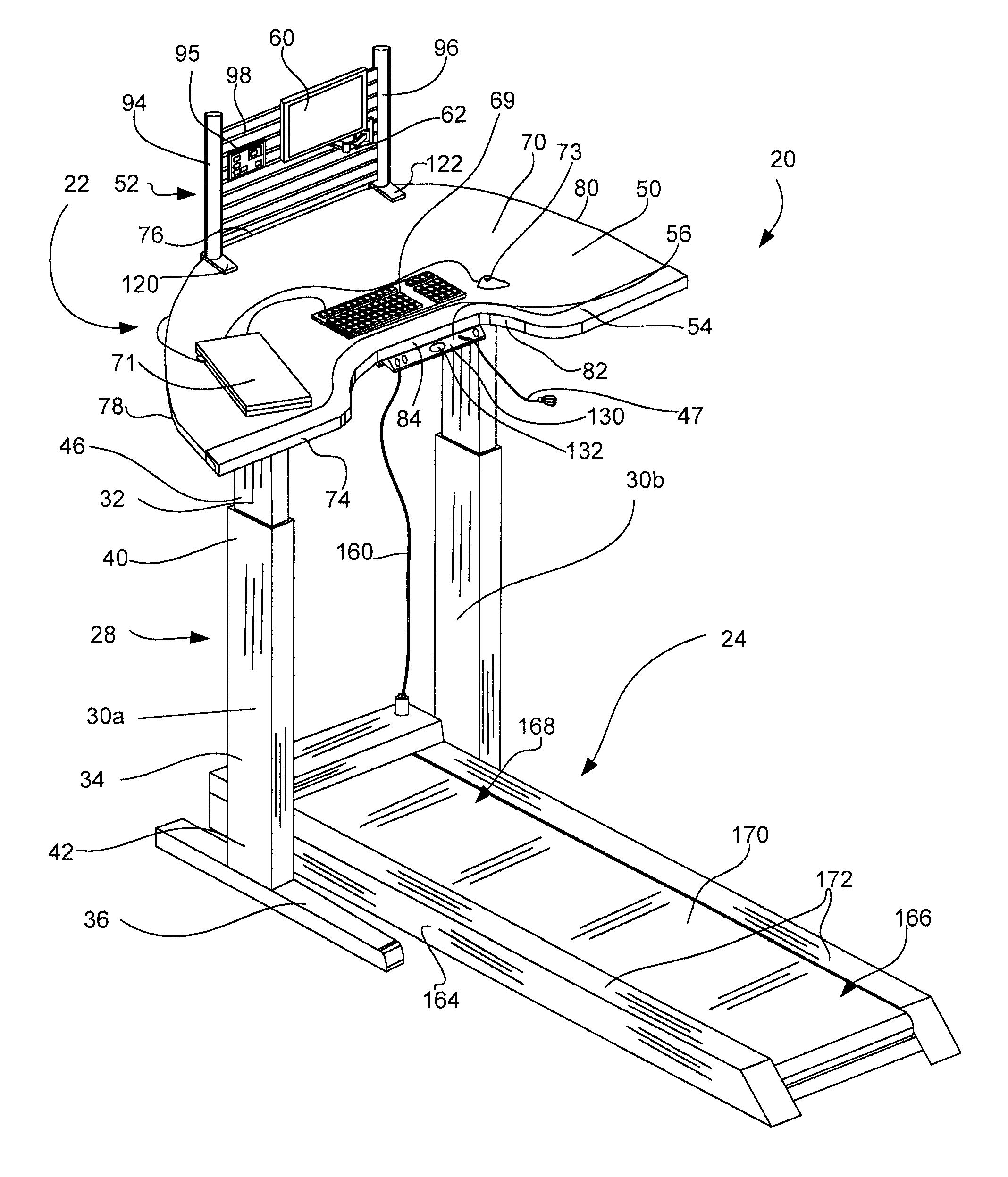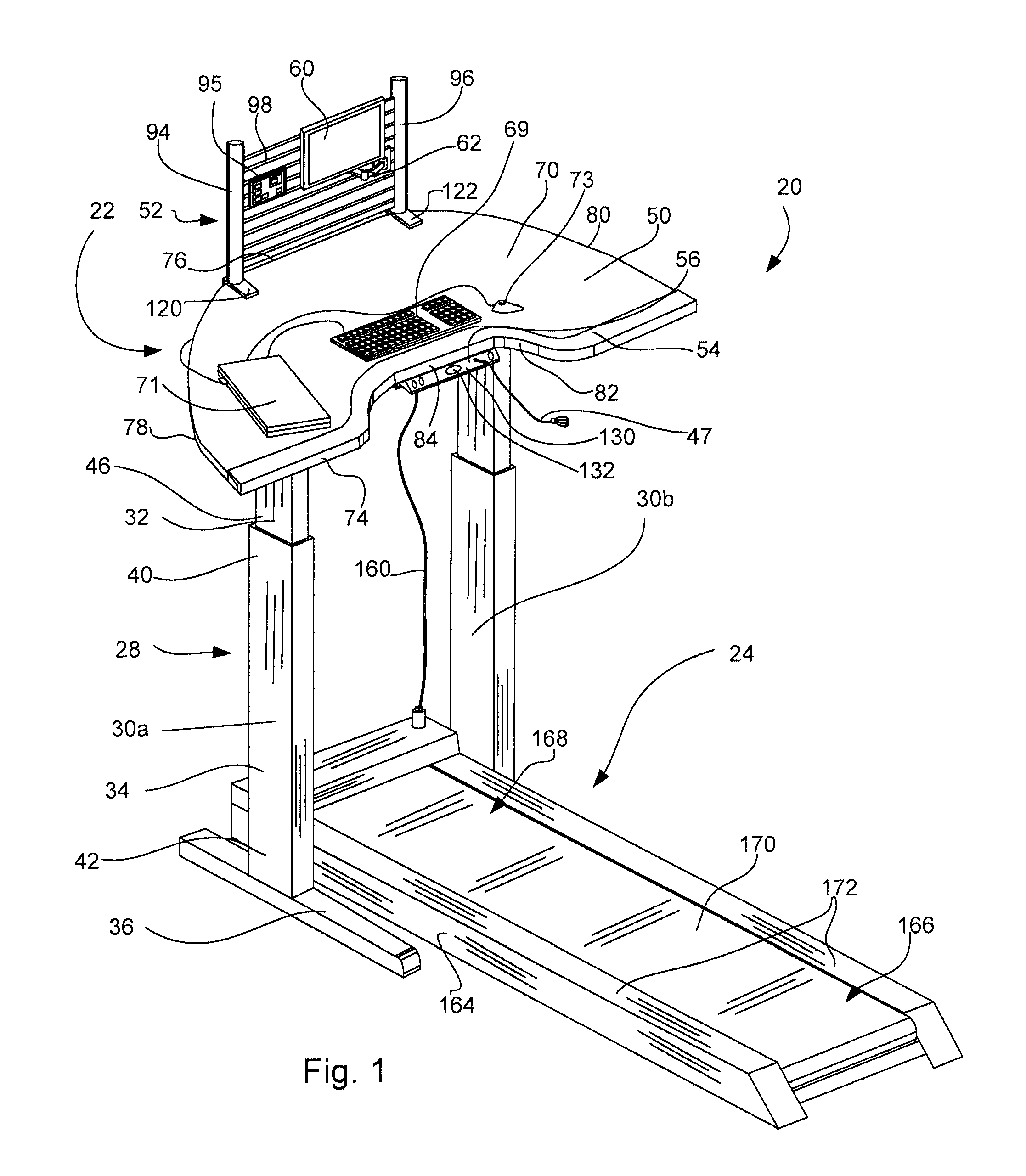According to the NEAT research, the cumulative
impact of such an energy imbalance over months and years often results in
obesity.
Unfortunately, a great majority of individuals do not actively participate in exercise and
health related activities so that
thermogenesis is often negligible and therefore NEAT contributes substantially to the inter- and intra-personal variability in EE.
In affluent countries, industrialization often converts high-NEAT jobs to lower-NEAT jobs which are associated with increased
obesity rates.
While known treadmill /
workstation configurations enable users to increase NEAT while working, unfortunately, known configurations have several shortcomings.
First, known treadmill /
workstation configurations do not have easily accessible control buttons (i.e., start, stop, speed increase, incline increase, etc.) and easily visible input / output assemblies.
Where a table top member resides in front of the input / output assembly, the assembly input components (e.g., buttons) and output components are often difficult to see while walking on the tread assembly and the input components are often difficult to reach as a user has to extend over the table top surface to access the input components.
Here, difficulty in accessing / seeing the input / output assembly is exacerbated when a
laptop or other computer components reside on the table top surface between the user and the input / output assembly.
Similarly, where a table top member resides above the input / output assembly, access top and view of the input / output assembly is blocked or severely impeded making it difficult for a user to control the tread assembly and to ascertain the current status of NEAT activities.
Second, known treadmill / workstation configurations include table top members that impede access to the lateral hand rails which reduces user stability.
Where the top member does not completely block access to rails, the top member usually substantially blocks access to the rails so that only the ends of the rails are exposed which can be difficult to grasp.
Third, while treadmill / workstation users like to be able to periodically check the status of their activities by observing the output components of the input / output assembly, it has been recognized that changing output can be distracting to a treadmill / workstation user while the user is trying to complete work tasks.
For instance, when a treadmill / workstation user is reading a document, changing digital readouts that reflect treadmill activities below a computer display screen can distract a
station user and adversely affect completion of the tasks.
In cases where a top surface resides between an input / output assembly and a user on the tread assembly so that the output components are
observable while using the tread assembly, the changing output is distracting.
Unfortunately this solution results in the workstation key board being further away from the workstation user which can be ergonomically incorrect.
Fourth, while treadmill / workstation configurations are useful, these configurations often require dedicated workstation components that make it necessary for a user to purchase a completely different set of duplicate components to configure a more typical workstation for normal use.
In many cases, while users recognize advantages of a treadmill / workstation, because most of their work day will be spent at a conventional workstation, the users cannot justify the added costs associated with an additional treadmill / workstation and they forego the benefits associated therewith.
Fifth, in cases where a table assembly straddles a treadmill, often the table assembly is relatively narrow in depth and therefore is not very sturdy.
In these cases, if a user grabs onto the table assembly it is believed that the table assembly and components supported thereby could be toppled which could damage the supported components.
Sixth, the table top surface of known treadmill / workstations is not optimally sized.
To this end, some treadmill / workstation top members have top surfaces that are only large enough to support a
laptop computer or the like and therefore are too small for facilitating many occupational activities.
When a top surface is too large, users are tempted to spread out materials thereon at locations that require the user to reach over extended spaces to access the materials which can cause
instability.
When moving toward a tread edge users can misjudge their location on the tread and have been known to inadvertently step off the tread at times.
Eighth, most treadmills have relatively high maximum speed limits that encourage users to run or jog on the tread during use.
Where a user jogs or runs, the user cannot typically concentrate on a display screen or use an
input device like a keyboard very well.
In addition, jogging and other
aerobic exercise is not consistent with NEAT exercise principles.
Here, in the event that a
station user needs to grasp the table edge to maintain balance, loose papers and / or a loose keyboard or the like may impede a good grip on the table edge and therefore the top member can often be rendered ineffectual as a stabilizing structure.
 Login to View More
Login to View More  Login to View More
Login to View More 


